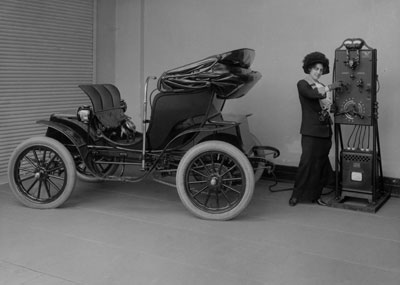
© CorbisThe missing piece of the electric-car jigsaw has just turned up
If you want to buy an electric car, you can. Tesla Motors, a firm based in San Carlos, California, will sell you a nifty open-top sports job for $109,000. Not cheap, admittedly, but cheap to run. Plugged in overnight, it can be refuelled for the equivalent of 25 cents a litre of petrol. The catch is, "plugged in overnight". Tesla's vehicles use standard lithium-ion battery cells. As any owner of a mobile phone or laptop computer knows, these take time to charge. If you use 6,831 of them, as a Tesla sports car does, that time does tend to drag on. Which is fine if you are not planning a long trip the following day, for a full charge will take you about 350km (220 miles). But it might cramp the style of anyone planning to bomb down from, say, Paris to Cannes, and who would therefore need to refuel on the way.
Gerbrand Ceder and Byoungwoo Kang of the Massachusetts Institute of Technology hope to change this, and thus help make the electric car a work-a-day consumer item, rather than a high-end boy's toy. In this week's
Nature they have published the technical details of a new battery material that will, if all goes well, take the waiting out of wanting, at least when it comes to recharging.
Broadly speaking, there are two ways of storing electrical energy in a chemical system. One is a standard battery, in which the whole material of the electrodes acts as a storage medium. That allows lots of energy to be squirrelled away, but makes it relatively hard to get at - and so it can be released or put back in only slowly. The other way is called a supercapacitor. This stores energy only at the surface of the electrode. It is quick to charge and discharge, but cannot hold much energy. The great prize in the battery world has thus been a material that can both store a lot and discharge rapidly, and it is this that Dr Ceder and Mr Kang think they have come up with.
NanogobstoppersLithium-ion batteries, as their name suggests, work by the movement of lithium ions (which carry a positive electric charge) along with electrons (which carry a negative charge). Electrons are small and mobile but lithium ions are much larger and slower. In a standard lithium-ion battery one electrode is made from a material such as lithium iron phosphate and the other from graphite. The ions pass from the graphite to the phosphate through an intervening electrolyte while the electrons make the journey via an external circuit that allows them to do useful work. When the battery is recharged, they go in the opposite direction. (See
videographic on how a lithium-ion battery works.)
It is the speed with which the ions can enter and leave the electrodes that governs how fast a battery can be charged and discharged. Graphite has an open structure and is easily penetrated. However, in the case of lithium iron phosphate and other, similar, materials, the crystal structure allows entrance and egress in only one direction. That creates a traffic jam that slows the movement of ions down.
What Dr Ceder and Mr Kang have done is create electrodes that are made of two different materials, one of which is good at storing ions while the other is good at conducting them. The two substances themselves are arranged in tiny spheres less than 50 billionths of a metre across. The core of each sphere is a crystal of lithium iron phosphate. This acts as a standard battery material. The surface, however, is made of a glassy (ie, non-crystalline) form of lithium phosphate. This lithium-phosphate glass is good at conducting lithium ions, though it cannot actually store many. It thus acts as a supercapacitor. The result is that any ion arriving at a sphere is quickly conducted around the surface by the supercapacitor phase until it finds its way to the right place to enter the battery phase in the core - or, if the battery in question is being charged, the other way round.
The really clever bit, though, is how the spheres are made. They crystallise from a melt that does not have enough iron in it to become pure lithium iron phosphate, so eventually no more of that material can form as the melt cools down. From then on the growing sphere is just lithium phosphate and, by manipulating the conditions, the researchers were able to make the coating glassy rather than crystalline.
The result is a material that, when tested in experimental batteries, was able to charge and discharge in a few seconds. In the future, therefore, that weekend in the south of France need not be interrupted by running out of juice.
Reader Comments
to our Newsletter